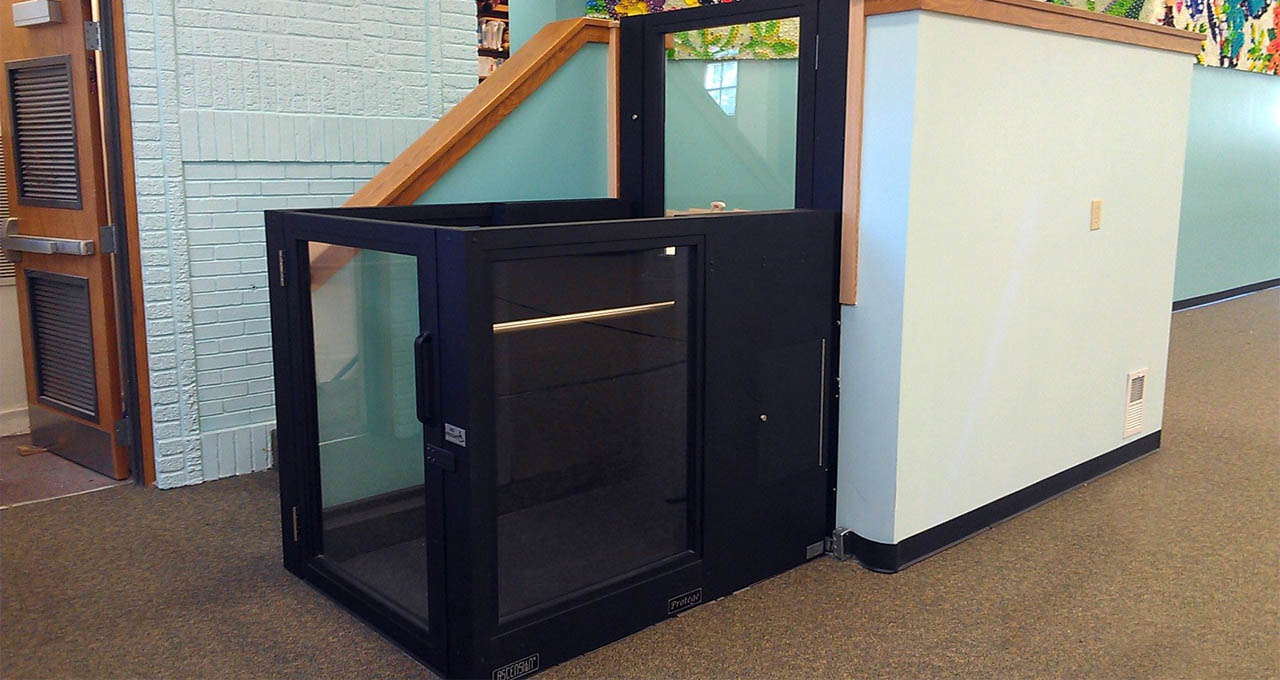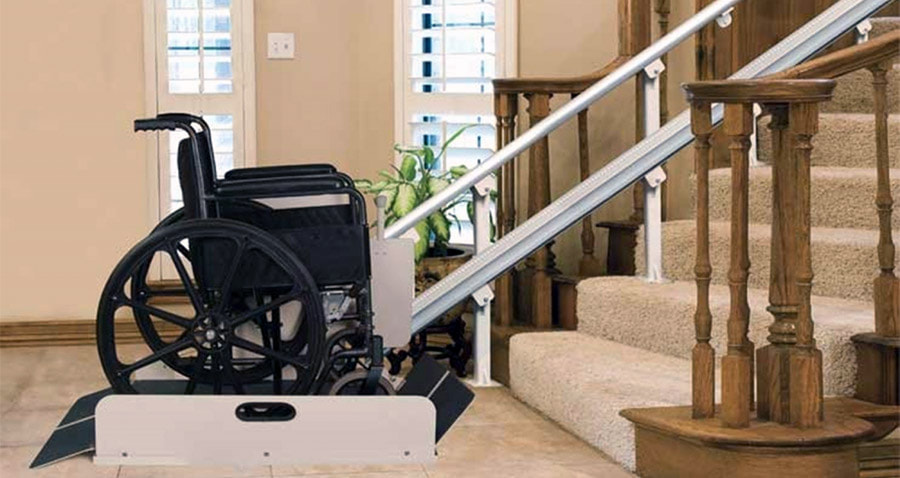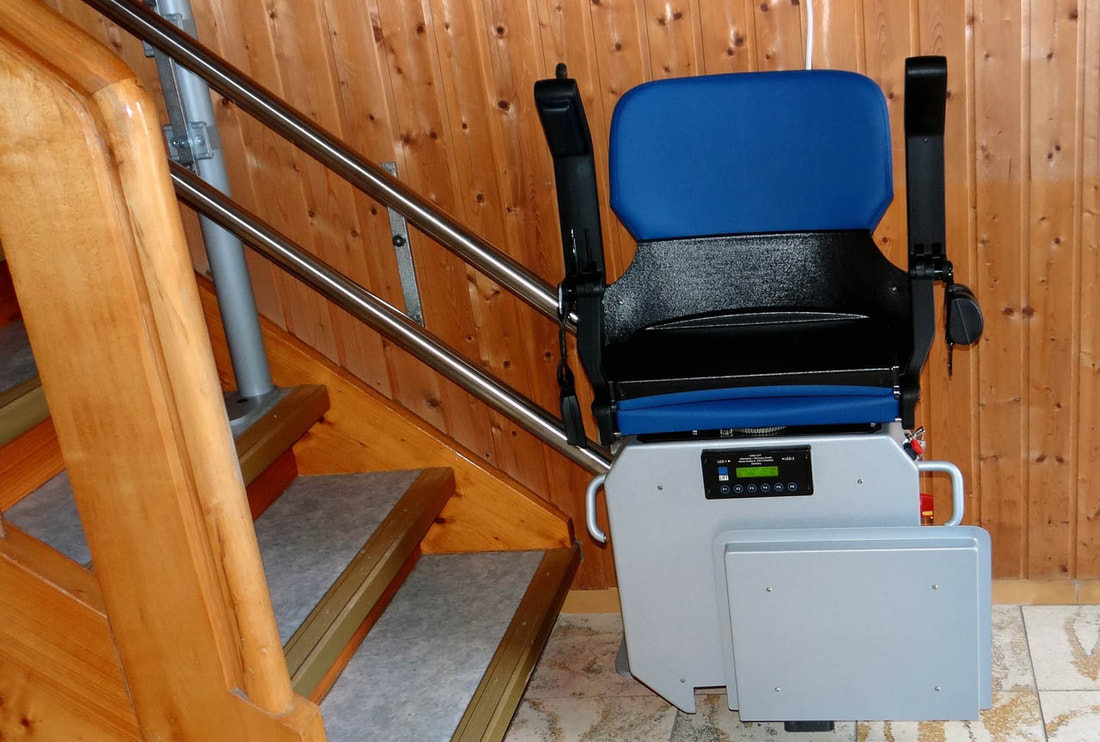|
By Anna Hazard
Introduction
Chair lifts (also known as stair lifts or lift chairs) are a popular solution for those seniors who live in multi-level homes whose health or mobility has deteriorated to the point that they can no longer safely maneuver common stairwells. These contraptions glide along rails that have been installed on the stair treads alongside the wall side of a staircase. Since they are not attached to the walls themselves, less remodeling is required with less traces left behind if the installation ever needs to be removed. In general, chair lifts can be set-up within 1 day which is a far quicker installation turnaround time than any type of residential elevator which can often take weeks to complete.
Although they are less accessible than residential elevators, stair lifts are often the most practical choice due to space and budget restrictions. They tend to be less expensive than the cheapest elevator option, particularly if the stairs being navigated are straight up and down (which usually starts at a couple thousand for installation of new unit). Costs go up for more complex layouts such as curving staircases or multiple level stairs with extra landings which can reach $10,000 depending upon the exact design. Stair lifts can also be temporarily rented for a couple hundred per month for those who only need their use for a limited amount of time (such as users recovering from surgery). Normal Chair-style Stair Lifts
Chair lifts can usually be retrofitted to most stair configurations as long as the staircase isn't too narrow. This usually requires a minimum width of at least 4 feet across the stairway to allow the chair platform to pass freely without any chance of bumping into the handrails as well as allowing enough passing room for another person on the steps during an emergency. Depending upon the exact style of stair lift being installed, their presence can be relatively discreet and take up a small amount of room. This equipment would include a small rail running alongside the lower wall of the stairs as well as the moving platform which would only be comprised of the chair itself (footrest, seat, and arms) which can often be folded up against the wall when not in use.
A normal style chairlift should come with seat buckles to help prevent any falling off the seat during use. Reeling seatbelts (similar to those found within cars) are more convenient as they will automatically recoil back into their holders when not in use (and thus present less chance of getting tangled or in the way). Four-point and five-point seat buckles are also available for more secure holds that can be easily fastened by the user or an outside assistant. Chairlifts should also always have enough of a reserve battery to be able to operate during emergencies and power outages. Households where more than one person may have need of the lift should also include a lift call button that moves the chair platform to the exact stair landing where it is needed. Other options (that will add on to the cost of a higher-end chair lift) would include slimmer operating profiles, higher weight capacities, power folding rails, as well as decorative options (color, seating materials) to better blend the lift with the rest of the home's decor. Drawbacks to chair lifts as opposed to elevators or vertical platforms include the necessity of having mobility aids available on each level where the lift is active. Since the chair lift is comprised of a single seat only, bulky mobility aids such as wheelchairs, scooters, or walkers can not be taken along with the person being transported. Thus, those requiring such aids while maneuvering through the house will need to have duplicates available at each stair landing for their use. Those seniors with more severe mobility or health issues will also require the presence of assistants at both landings to help get on or off the chair lift and unto their normal mobility aid. 
Protégé Vertical Platform Lift available at ascension-lift.com
Wheelchair Stair Lifts
For those users with more severely limited mobility where accessing the chair of a normal stair lift would be problematic or who otherwise need to bring their bulky mobility aids (such as wheelchairs or scooters) with them when ascending stairs, there are wheelchair stair lifts. This type of lift would include larger open air platforms for movement instead of standalone chairs.
These types of installations are rarer than normal chair lifts and are generally more expensive and take up more space, but are still less time & money consuming as compared to full residential elevators. Most wheelchair stair lifts are meant for operating between two levels only (although more expensive multiple level options are available, these are more commonly found for commercial use). Since these types of lifts allow the user to take their mobility aids (as well as other items on hand, such as packages) with them, they do not necessitate the use of a different mobility aid on each level of the house being accessed as the use of a normal chairlift would require. Similar to their outdoor variations, two types of interior wheelchair lifts are available - the vertical platform lift and the inclined platform wheelchair lift. Vertical Platform lifts are similar to open air elevators that can only move directly up and down between different levels. When installed on the exterior of houses they are often known as "porch lifts". They are suitable for use with steep inclines or for bypassing staircases that are too narrow for normal or inclined chairlifts. While these installations take up much more room than a normal chair lift, they are often used in place of ramps which can take up even more room when the vertical distance being maneuvered is greater than a few feet. A drawback to vertical platform lifts is they tend to have weight requirements that require the installation of a concrete pad base beneath their bulk. Inclined Platform Wheelchair Lifts are more similar to normal chair lifts with larger platforms suitable for transporting wheelchairs and scooters rather than a stand-alone seat. They are particularly good for curved staircases that are not suitable for other styles of lifts as well as wide and straight stairs. These type of lifts run along a rail that can sometimes be directly attached to the staircase wall, thus this style of lift requires sturdy wall structure and also a wider staircase due to the size of the platform being transported. While many styles of inclined platform wheelchair lifts can be folded up when not in use, they will generally take up quite a lot of room along the staircase, especially when in use. 
Indy Inclined Wheelchair Lift available at elevators.com
Wheelchair Lift Option
If the budget will allow, the higher model inclined platform lifts are recommended that include motorized folding and unfolding of the platforms, thus removing the need for the user or assistant to bend over and manually lift & fold the platform (and thus bypassing the risk of someone injuring themselves while doing this). Some designs also include optional fold down seats which will allow the inclined platform lift to operate as a normal chair lift.
In addition, when it comes to all types of wheelchair lifts, keep in mind the total weight that will be transported (which includes the user, any mobility aids, and any incidental packages being carried). Weight limits on lifts can vary depending upon the design of the lift, but tend to generally be in the range of 500 - 750 lbs for inclined platform wheelchair lifts while vertical platform lifts can often take up 1500+ lbs. The platform shape, size, and configuration will also need to be taken in mind, not only when it comes to fitting the lift unto the stair case, but also when determining if the currently used wheelchair or scooter will comfortably fit unto the platform. All configurations of wheelchair lifts should have grab bars on all sides for stability (in case the user should lose their balance and need something to hold unto) as well as curbs to keep wheelchair, scooter, and walker wheels from rolling off the sides. Other essentials include an on board emergency stop button, as well as automatic sensors that can detect obstructions along the lift's route and stop its progress. View the Rest of the Series
Part 1 - Introduction
Part 2 - Exterior Part 3 - Landscaping & Gardens Part 4 - Patio, Porch, & Deck Part 5 - Garage & Carports Part 6 - Entrances, Exits, & Thresholds Part 7 - Exterior Steps & Ramps Part 8 - Threshold Lighting & Windows Part 9 - Interior Doors & Halls Part 10 - Interior Steps & Staircases Part 11 - Interior Stairlifts Part 12 - Interior Elevators Part 13 - Living Room Part 14 - Kitchen
5 Comments
6/20/2019 01:25:52 am
Hey very nice blog. I came across this on Google, and I am stoked that I did. I will definitely be coming back here more often. Wish I could add to the conversation and bring a bit more to the table, but am just taking in as much info as I can at the moment. Thanks for sharing.
Reply
3/8/2021 10:52:23 am
My mom tells me that her old back makes it hard to get up and down her stairs, so I want to help her out. It makes sense that installing a stair lift for this would be a great idea! I'll make sure that we get one that has a reserve battery that lasts a long time. That way, she'll be able to use the stair lift even if there's an emergency.
Reply
12/1/2021 11:49:08 pm
I like how you mentioned that it is important to keep in mind the total weight that will be transported when it comes to all types of wheelchair lifts. My cousin mentioned to me last night that he is planning to have a stairlift installed in their home for my aunt due to old age and asked if I have any idea where is the best option to buy. Thanks to this informative article and I'll be sure to tell him that he should check home health care service as they can answer all her inquiries.
Reply
6/25/2023 08:49:32 am
I found the information about wheelchair stair lifts and interior wheelchair lifts very informative. Overall, this article provides valuable insights into the different types of wheelchair lifts available and their respective advantages and considerations. And I agree that while these installations may be rarer and more expensive than normal chair lifts, they provide a convenient solution for individuals with mobility challenges. Thanks for sharing.
Reply
It's interesting to know that there are wheelchair lifts with an optional fall-down seat so that the platform will operate as a normal chair lift. I will share this information with my dad because he plans to get one installed on their property now that he is starting to have mobility problems. So he wants to be prepared when the time comes that he already needs to use a wheelchair for himself or for my mom.
Reply
Leave a Reply. |
AboutNews updates, tips, and guides on senior care, senior health, stress relief and a host of other caregiving related topics from the professionals at Ella Stewart Care. |




 RSS Feed
RSS Feed
